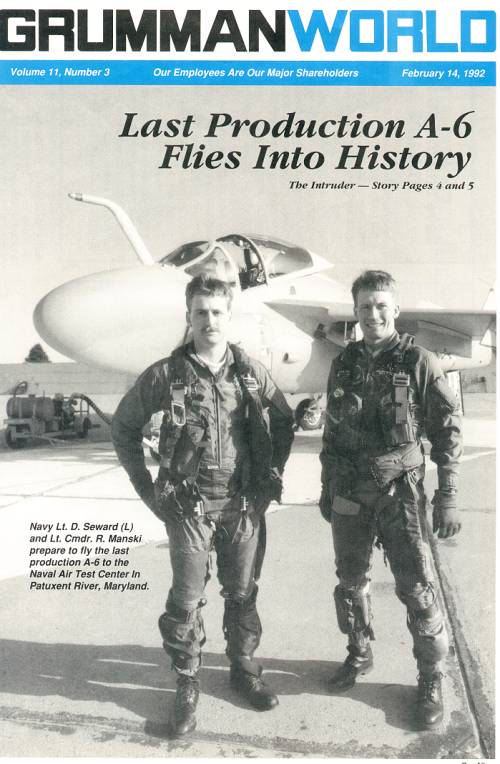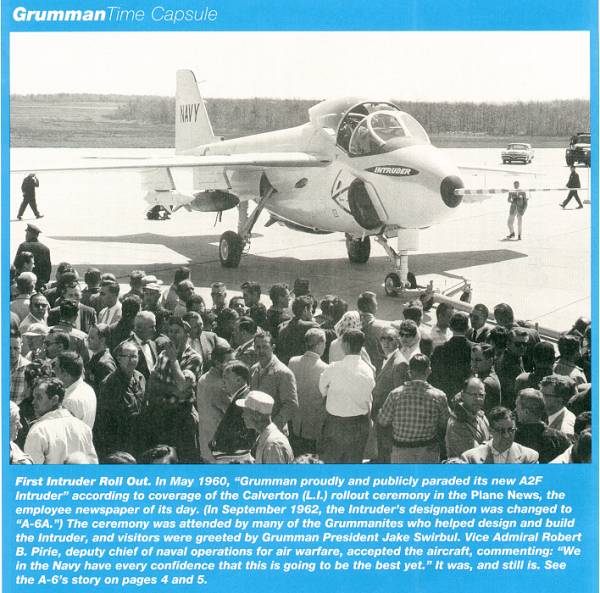

"This weapons delivery system is unprecedented as a carrier or short-field attack aircraft," said Grumman President Jake Swirbul at the Intruder's May 1960 rollout ceremony in Calverton. "We feel that the aircraft is suitable for a variety of missions vital to the country's current and future defense preparations."
Those words proved to be prophetic. Not sleek, never beautiful, the A-6 would soon prove itself to be a masterpiece of aeronautical engineering. Equipped with its innovative Digital Integrated Attack Navigation Equipment(DIANE), the A-6 became the Navy's workhorse bomber and the Marines' primary ground support aircraft in Vietnam about a year after development and testing were completed. It would prove its amazing versatility there as well.
A Distinguished Combat Record
Attack Squadron 75 arrived in the Gulf of Tonkin with new A-6A's(capable
of carrying up to 18,000 lbs. of armament -- bombs, mines, and missiles) aboard the
USS Independence in 1965. The A-6 remained an important factor until America's air
involvement ended early in 1973. "On almost every type of strike mission
or requirement, the A-6 could do the job better than other aircraft in Vietnam,"
retired A-6 squadron commander Milton Beach told the Navy Times recently.
Special versions of the A-6 were developed for the Vietnam conflict. Beginning in 1967, the A-6B defense suppression aircraft arrived on the scene. With most of the attack systems removed, the A-6B detected and eliminated radar that controlled surface-to-air missiles. In 1970, A-6C's began operations off the USS Enterprise, Equipped with the Trails-Roads Interdiction Multi-sensor(TRIM), they detected, tracked, and attacked vehicles operating clandestinely at night on the Ho Chi Minh Trail -- North Vietnam's supply line into the south.
In 1971, the KA-6D refueling aircraft joined the fray. As with the A-6B, most specialized attack systems had been removed, but the KA-6D retained a secondary visual bombing capability while fulfilling its primary mission of increasing the loiter time and mission radius of other A-6s. An electronic jamming version of the A-6 -- the EA-6A -- was developed for the marines in 1963, and the excellent service it provided in Vietnam led to the development of the four-seat EA-6B, which had its maiden flight in 1968.
In 1983, the A-6 flew combat sorties over Grenada and Lebanon. Operating in the Gulf of Sidra, in 1986, A-6s participated in retaliatory strikes against Libya, sinking a missile patrol boat and striking barracks in Tripoli.
And last winter, almost 20 years after Vietnam, the latest version of the Intruder -- the A-6E -- again carried the bulk of the Navy's workload. The A-6 got top marks from the Chief of Naval Operations when that office issued a report card on naval aviation's performance during Desert Storm. The Intruder and Prowler also helped the Marines provide support that kept ground casualties to a minimum.
The Intruder has upheld Grumman's Iron Works reputation in the fleet. " Thank you very much for building an airplane that can withstand serious punishment and still allow the aircrew to return home safely," wrote Lt. Mark F. Eddy to his friends at Grumman. Despite being heavily damaged by an exploding surface-to-air missile, Eddy's A-6 got him and his pilot safely back on the ground.
More Than 700 Built
Over the A-6's extraordinary 32-year history, Grumman has built more than 700
Intruders. "When we won the contract, we thought that it would be successful
if we could sell 100 Intruders," Larry Mead told Plane News in 1980 on the
occasion of the sale of the 600th Intruder. "We thought that we would be building
them for five or ten years."
Mead headed the Grumman team that submitted the winning design to replace the Douglas AD Skyraider. Both Navy and Marine Corps were looking for an all-weather, day or night attack aircraft -- something they lacked during the Korean conflict. The Grumman design was chosen over 10 others. "One reason was our side-by-side seating, which made it easier for the pilot and bombardier-navigator to work together," said Mead.
The first Intruder, called A2F-1 at the time, had its first flight on April 19, 1960.
Grumman test pilot Bill Smyth later commented that the flight was uneventful --
the only problem was the need to adjust a switch that controlled the landing gear.
The plane was formally accepted by the Navy at a rollout ceremony in Calverton a
few weeks later.

The A-6F, a major upgrade, was developed but never produced(nor was a scaled-back
version, the A-6G) because Congress believed the attack version of the F/A-18
was a better interim investment while the Intruder's replacement -- the Advanced
Tactical Aircraft, or A-12 -- was being developed. Just over one year ago, Secretary of
Defense Dick Cheney canceled that program when it was discovered to be behind schedule
and over budget.
